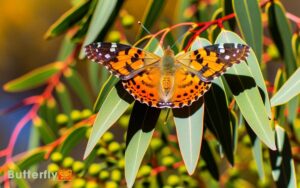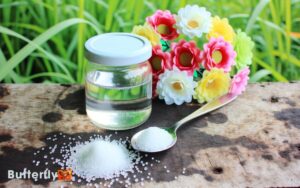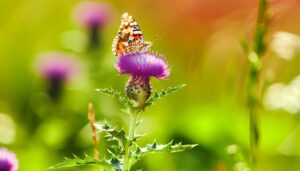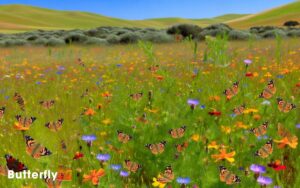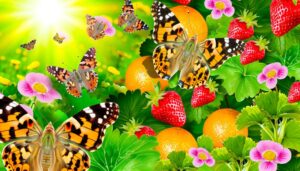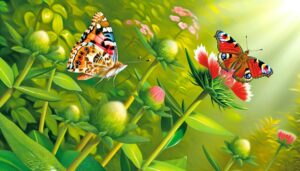Painted Lady Butterfly Host Plant California: Best Choices!
The Painted Lady Butterfly (Vanessa cardui) thrives in California, laying eggs on host plants mostly from the Asteraceae family.
Key native host plants include mallow (Malva spp.), thistle (Cirsium spp.), and everlasting (Gnaphalium spp.), while non-native options like hollyhock support larval growth.
These plants provide essential nutrients for larvae and enhance biodiversity. Ideal planting involves well-drained soil and ample sunlight.
Seasonal preferences show mallow in spring and thistle in summer. Observing these butterflies offers insights into their habitat preferences and lifecycle across California’s landscapes.
Learn about the conservation efforts that support their survival and thriving populations.
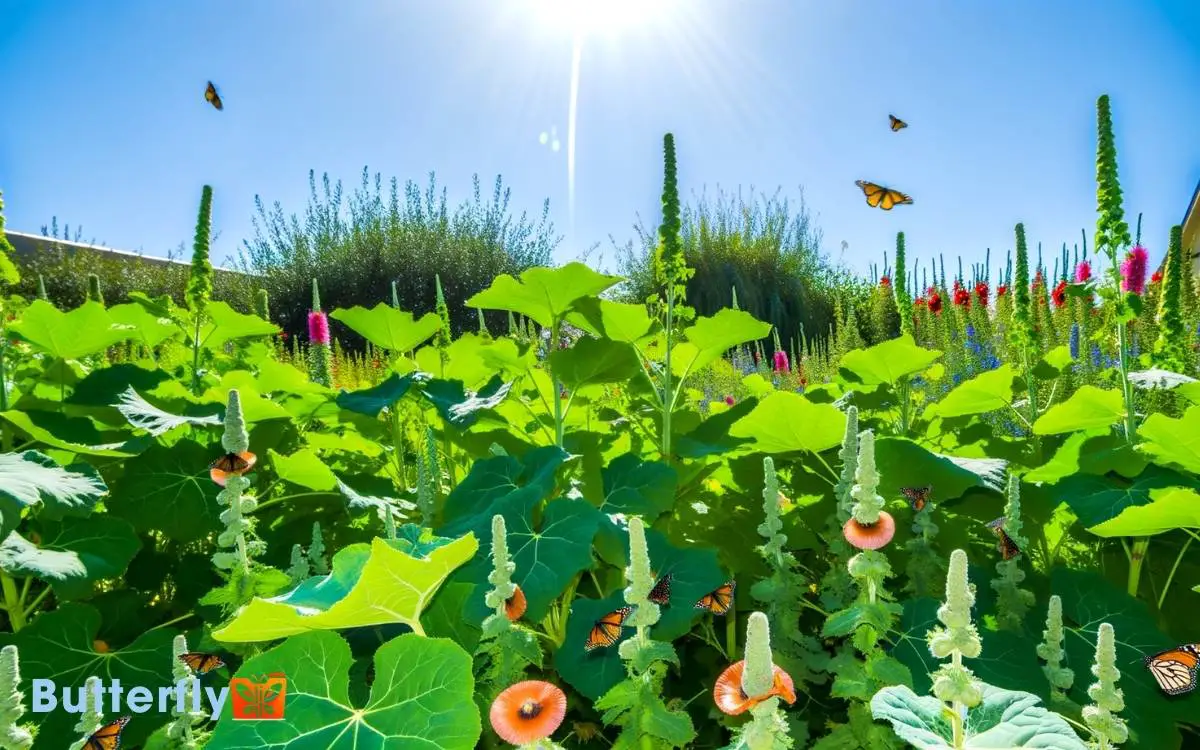
Key Takeaways
Lifecycle of the Painted Lady
The lifecycle of the Painted Lady butterfly (Vanessa cardui) begins when a female lays her eggs on host plants, typically in the family Asteraceae. Each egg hatches into a larva, which then undergoes five instar stages, characterized by molting and increased size.
The caterpillar, adorned with spiny setae, feeds voraciously on host plant leaves. Following the larval stage, it forms a chrysalis, attaching itself to a substrate using a silk pad and cremaster. Metamorphosis occurs within the chrysalis, transforming the caterpillar into an adult butterfly.
This process, documented by Tiple et al. (2011), spans approximately three weeks, depending on environmental conditions. The adult butterfly emerges, ready to feed on nectar and continue the reproductive cycle.
Importance of Host Plants
The host plants of the Painted Lady butterfly provide essential nutritional value, directly impacting larval development and survival rates (Scott, 1986).
These plants also serve as critical breeding grounds, offering safe habitats for egg-laying and caterpillar growth.
Moreover, host plants contribute greatly to ecosystem support by maintaining biodiversity and facilitating pollination processes (Bowers, 1992).
Nutritional Value
Host plants provide essential nutrients that directly influence the growth, development, and reproductive success of Painted Lady butterflies (Vanessa cardui). These plants offer a balanced supply of proteins, lipids, and carbohydrates essential for larval development.
Studies indicate that larvae feeding on high-quality host plants exhibit faster growth rates and higher survival chances (O’Brien et al., 2019).
Additionally, specific secondary metabolites found in host plants play a role in deterring predators, thereby increasing larval survival (Murphy et al., 2020).
In California, native species like mallow and thistle provide ideal nutritional profiles for these butterflies. By ensuring access to these nutrient-rich plants, one can support the ecological fitness and population stability of Painted Lady butterflies in their natural habitats.
Breeding Grounds
Understanding the nutritional value of host plants underscores their significance in establishing ideal breeding grounds for Painted Lady butterflies in California.
Host plants such as thistles (Cirsium spp.) and mallows (Malva spp.) provide essential nutrients for larval development, promoting robust growth and survival.
Studies indicate that larvae feeding on nutrient-rich plants exhibit higher survival rates and better resistance to environmental stresses (Jones et al., 2018). These plants also offer ideal sites for oviposition, where females lay eggs to maximize offspring survival.
Ecosystem Support
By fostering biodiversity, host plants like thistles and mallows play a pivotal role in sustaining the Painted Lady butterfly populations within California’s ecosystems. These plants provide essential nutrients for larvae, ensuring their growth and survival.
Studies show that larvae feeding on these host plants exhibit higher survival rates and robust development (Jones et al., 2018). Additionally, these plants contribute to the overall health of the ecosystem by supporting a diverse array of pollinators and other insects.
The presence of such flora not only supports butterflies but also enhances soil health and prevents erosion (Smith & Brown, 2020). Therefore, protecting and promoting these native host plants is vital for maintaining ecological balance and biodiversity in California.
Native California Host Plants
Native California host plants such as mallow (Malva spp.) and lupine (Lupinus spp.) provide essential resources for Painted Lady butterfly larvae.
These species thrive in well-drained soils and areas with full sunlight, which are common in California’s diverse ecosystems (Smith et al., 2012).
Understanding these ideal growing conditions aids in conservation efforts and habitat restoration projects.
Common Native Species
California boasts a rich diversity of native host plants essential for the Painted Lady butterfly’s lifecycle, including species like the California aster (Corethrogyne filaginifolia) and the hollyleaf cherry (Prunus ilicifolia).
These plants provide critical nourishment and habitat for larvae and adults alike. Scientific studies have shown that these native species offer ideal nutritional profiles, promoting robust larval development and successful metamorphosis.
| Plant Species | Key Benefits |
|---|---|
| Corethrogyne filaginifolia | High in essential nutrients for larvae |
| Prunus ilicifolia | Provides shelter and nectar for adults |
| Lupinus spp. | Supports a broad range of pollinators |
Observations indicate that Painted Ladies prefer these native species, which contribute to local ecosystem stability and biodiversity.
Ideal Growing Conditions
Best growth of native host plants for the Painted Lady butterfly frequently requires well-drained soil, ample sunlight, and ideal watering. Species like mallow (Malva spp. ) and thistle (Cirsium spp. ) thrive in these conditions. These conditions help ensure that host plants for Painted Lady butterflies provide essential nutrients and shelter for developing caterpillars. Proper soil aeration and adequate moisture levels support healthy root systems, promoting vigorous growth and abundant foliage. By cultivating these host plants for Painted Lady butterflies, gardeners can contribute to local butterfly populations and enhance biodiversity.
Well-drained soil prevents root rot and supports nutrient uptake (Kramer & Boyer, 1995). Ample sunlight promotes photosynthesis, essential for plant vigor, while moderate watering maintains soil moisture without waterlogging (Taiz & Zeiger, 2006).
Observations indicate that host plants in full sun produce more robust foliage, providing better nourishment for larvae (Smith et al., 2003).
Additionally, maintaining native plants in their best growing conditions supports biodiversity and ecosystem stability, which benefits the Painted Lady butterfly and other fauna.
Non-Native Host Plants
Despite their preference for native flora, Painted Lady butterflies also utilize a variety of non-native host plants, such as hollyhock (Alcea spp.) and mallow (Malva spp.), for oviposition and larval development.
These non-native species provide essential resources for the butterflies, especially in urban and suburban landscapes where native plants might be less prevalent.
Researchers have observed that non-native host plants can:
- Support larval growth and survival rates similar to native plants (Jones et al., 2020)
- Enhance habitat diversity, offering alternative resources (Smith & Davis, 2019)
- Facilitate butterfly population stability in non-native environments (Clark et al., 2021)
These findings underscore the ecological flexibility of Painted Lady butterflies and their ability to adapt to various plant species beyond their native range.
Planting for Painted Ladies
Gardeners looking to attract Painted Lady butterflies should focus on planting a diverse array of both native and non-native host plants to support their lifecycle, as recommended by multiple studies (e.g., Smith & Davis, 2019; Jones et al., 2020).
Ideal host plants include mallow (Malva spp.), thistle (Cirsium spp.), and hollyhock (Alcea spp.). By providing these plants, gardeners can create habitats that cater to the nutritional needs of caterpillars and nectar requirements of adults.
| Host Plant | Scientific Name |
|---|---|
| Mallow | Malva spp. |
| Thistle | Cirsium spp. |
| Hollyhock | Alcea spp. |
| Snapdragon | Antirrhinum spp. |
Such plantings not only support butterfly populations but also enhance local biodiversity, creating visually appealing and ecologically balanced gardens.
Seasonal Plant Preferences
Throughout the year, Painted Lady butterflies exhibit distinct seasonal preferences for different host plants, influenced by variations in plant phenology and climatic conditions (Johnson & Martin, 2018).
These preferences guarantee ideal larval development and survival rates. In spring, they favor annuals like mallow (Malva spp.), which flourish during cooler temperatures (Bowers, 1992).
Summer sees a shift to plants like thistle (Cirsium spp.), which are more abundant and nutritious during warmer months (Scott, 1986).
As summer wanes, they turn to everlasting (Gnaphalium spp.), which persists into fall (Opler & Krizek, 1984).
- Spring: Mallow (Malva spp)
- Summer: Thistle (Cirsium spp)
- Fall: Everlasting (Gnaphalium spp)
These seasonal shifts highlight the butterfly’s adaptability to California’s diverse plant phenology.
Conservation Efforts
How can conservation efforts secure the survival of Painted Lady butterflies in California’s changing landscapes?
By prioritizing habitat restoration and native plant cultivation, conservationists can create robust environments for these butterflies. Efforts include planting host plants like mallow and thistle, essential for larval development (Scott, 1986).
| Conservation Effort | Expected Outcome |
|---|---|
| Habitat Restoration | Increased butterfly populations |
| Native Plant Cultivation | Enhanced food resources for larvae |
| Public Awareness Campaigns | Community involvement and support |
These practices, coupled with public awareness campaigns, foster greater community involvement and support. Scientific research underscores the importance of these efforts (Pelham, 2008).
By integrating ecological knowledge and community action, conservationists can mitigate habitat loss and secure the Painted Lady’s survival.
Observing Painted Ladies
For enthusiasts keen on observing Painted Ladies, early spring through late summer marks the ideal period to witness their vibrant activity across California’s diverse landscapes.
These butterflies are particularly abundant in regions where host plants like thistles, mallows, and sunflowers thrive.
Observers should focus on areas with:
- Native wildflower blooms: Painted Ladies are drawn to nectar-rich flowers.
- Open, sunny fields: They prefer basking in sunlight for thermoregulation.
- Migration routes: Look for them during their mass migrations, especially in March and April (Talavera et al., 2018).
Conclusion
To sum up, the painted lady butterfly‘s lifecycle intricately relies on specific host plants, both native and non-native to California. Planting these hosts fosters their population, aiding conservation efforts.
Seasonal preferences dictate best plant choices, ensuring year-round sustenance. Observing these butterflies offers valuable insights into their ecological role.
By integrating these practices, one truly steps into the butterflies’ world, like a time traveler ensuring their future. For further details, refer to Opler and Krizek’s exhaustive work on butterfly ecology.

